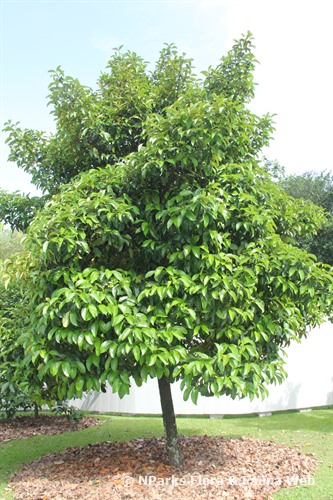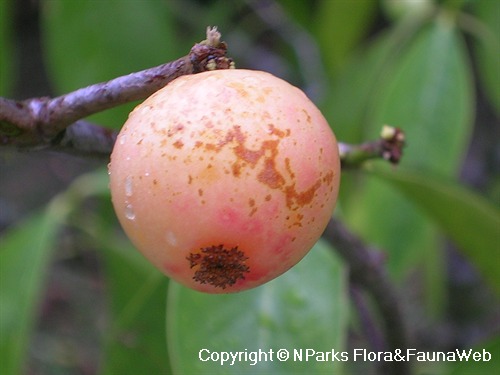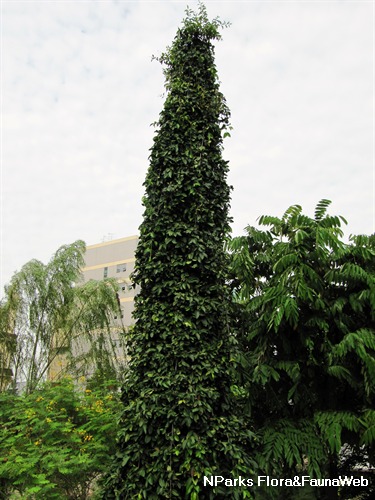
Back
Garcinia mangostana L. var. mangostana
| Family Name: | Clusiaceae (Guttiferae) |
| Common Name: | Mangosteen, Manggis, Mesetor, Sementah, Semetah, 山竹 |
Garcinia mangostana var. mangostana, also known as Mangosteen, is a tree which can reach up to 25 m tall. The fruit is round with persistent green calyx, and ripens dark purple. The white aril is sweet tasting and can be eaten fresh or made into desserts.
Name
Classifications and Characteristics
| Plant Division | Angiosperms (Flowering Seed Plants) (Dicotyledon) |
|---|---|
| Plant Growth Form | Tree |
| Lifespan (in Singapore) | Perennial |
| Mode of Nutrition | Autotrophic |
| Maximum Height | 25 m |
Biogeography
| Native Distribution | Peninsular Malaysia |
|---|---|
| Native Habitat | Terrestrial |
| Preferred Climate Zone | Tropical |
| Local Conservation Status | Non-native (Horticultural / Cultivated Only) |
Description and Ethnobotany
| Foliage | Large leaves are elongated with smooth margins. |
|---|---|
| Fruit | The dark purple, round fruit is crowned by thick, persistent calyces (the outermost layer of the flower). The thick, fibrous rind protects white, fleshy segments that are arranged like a peeled mandarin orange. The flesh is juicy and sweet with a slightly acidic taste. The number of fleshy segments is proportional to the number of brown to grey, triangular lobes at the bottom of the fruit. |
| Cultivation | It is difficult to cultivate this species for fruit, because seedling mortality rate is high and trees only begin to produce fruits after 8-15 years. |
| Ethnobotanical Uses | Edible Plant Parts : Edible Fruits Food (Fruit or Vegetable): The fruit is best eaten fresh, because processing tends to ruin the flavour. It is sometimes eaten with sherbert or ice cream. The fruit tends to be in season at the same time as Durian. Some Chinese like to eat the fruits together, because they believe mangosteen has a cooling effect, while durian has a heating effect. Medicinal: In many Asian countries, the bark and fruit skin are used to treat diarrhea and dysentery. The rind contains a high concentration of tannin and is also used to treat dysentery. The Malays use a decoction of the roots to treat irregular menstruation. In Indonesia, the bark and leaves are considered astringent and also used to control fever. Others: The sap of the mangosteen has been used as a black coloring agent to dye silk. It stains fabric and may also linger on your hands for some time as well. |
Landscaping Features
| Landscape Uses | Parks & Gardens |
|---|---|
| Thematic Landscaping | Economic Garden |
Plant Care and Propagation
| Light Preference | Full Sun, [Remarks] (The seedlings need 505-795 shade for the first 3-years before can be grown in full sun.) |
|---|---|
| Water Preference | Little Water |
| Plant Growth Rate | Moderate |
| Rootzone Tolerance | Well-Drained Soils, Fertile Loamy Soils |
| Propagation Method | Seed |
Foliar
| Foliage Retention | Evergreen |
|---|---|
| Mature Foliage Colour(s) | Green |
| Mature Foliage Texture(s) | Glossy / Shiny, Leathery, Thick |
| Foliar Type | Simple / Unifoliate |
| Foliar Arrangement Along Stem | Opposite |
| Foliar Attachment to Stem | Petiolate |
| Foliar Shape(s) | Non-Palm Foliage (Elliptical, Oblong) |
| Leaf Area Index (LAI) for Green Plot Ratio | 4.0 (Tree - Dense Canopy) |
Fruit, Seed and Spore
| Mature Fruit Colour(s) | Purple |
|---|---|
| Fruit Type | Fleshy Fruit |
References
| References | Phillipps K. & M. Dahlen. 1985. A Guide to Market Fruits of Southeast Asia. Hong Kong: South China Morning Post. 132 pp. Piper, J.M.. 1989. Fruits of South-East Asia Facts and Folklore. Singapore: Oxford University Press. 94 pp. |
|---|
Image Repository
Others
| Master ID | 1634 |
|---|---|
| Species ID | 2927 |
| Flora Disclaimer | The information in this website has been compiled from reliable sources, such as reference works on medicinal plants. It is not a substitute for medical advice or treatment and NParks does not purport to provide any medical advice. Readers should always consult his/her physician before using or consuming a plant for medicinal purposes. |











